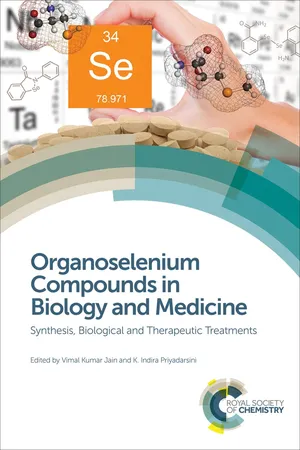
Organoselenium Compounds in Biology and Medicine
Synthesis, Biological and Therapeutic Treatments
- 457 pages
- English
- ePUB (mobile friendly)
- Available on iOS & Android
Organoselenium Compounds in Biology and Medicine
Synthesis, Biological and Therapeutic Treatments
About this book
Organoselenium shows incredible promise in medicine, particularly cancer therapy. This book discusses organoselenium chemistry and biology in the context of its therapeutic potential, taking the reader through synthetic techniques, bioactivity and therapeutic applications.
Divided into three sections, the first section describes synthetic advances in bioactive selenium compounds, revealing how organoselenium compound toxicity, redox properties and specificity can be further tuned. The second section explains the biophysics and biochemistry of organoselenium compounds, as well as selenoproteins. The final section closes with several chapters devoted to therapeutic and medicinal applications of organoselenium compounds, covering radioprotectors, anticancer agents and antioxidant behaviour.
With contributions from leading global experts, this book covers recent advances in the field and is an ideal reference for those researching organoselenium compounds.
Frequently asked questions
- Essential is ideal for learners and professionals who enjoy exploring a wide range of subjects. Access the Essential Library with 800,000+ trusted titles and best-sellers across business, personal growth, and the humanities. Includes unlimited reading time and Standard Read Aloud voice.
- Complete: Perfect for advanced learners and researchers needing full, unrestricted access. Unlock 1.4M+ books across hundreds of subjects, including academic and specialized titles. The Complete Plan also includes advanced features like Premium Read Aloud and Research Assistant.
Please note we cannot support devices running on iOS 13 and Android 7 or earlier. Learn more about using the app.
Information
1.1 Introduction
- (i) Role in organic chemistry: since its discovery in the early 1930s as an oxidizing agent for organic compounds,3 selenium dioxide (SeO2) was used predominantly in organic synthesis until the early 1970s. However, around this time several useful reactions and processes were discovered4–6 and the interest in organoselenium compounds was further catalysed with the publication of a monograph by Klayman and Günther.7 Since then, the number of reactions as well as the variety of selenium compounds have grown dramatically.8 Selenium can be introduced to a myriad organic substrates as an electrophile, nucleophile or even as a radical in a chemo-, regio- and stereo-selective manner.
- (ii) Organometallic chemistry and materials science: although metal complexes of seleno ligands (e.g. [PtCl2(R2Se)2]; R=Me, Et, Prn, Ph) were first synthesized more than a century ago,9 reports on organoselenium complexes appeared only sporadically until the early 1990s,10 possibly due to poorly developed synthetic processes for the desired organoselenium compounds. Selenium ligands quite often show unusual reactivity that differs from their sulfur counterparts.11 Platinum group metal complexes with seleno ligands were developed as catalysts for various reactions since the 1990s,12–14 and in some cases exhibit even better catalytic activity than the corresponding thio derivatives.12 Further impetus to selenium chemistry comes from recent interest in semiconductor metal selenide nano-materials.15–17 Metal selenolates have emerged as versatile single-source molecular precursors for the synthesis of nano-particles and deposition of thin films of metal selenides.
- (iii) Selenium in biology:18 selenium was long considered a poison until 1957 when Schwarz and Foltz identified it as an essential micronutrient.19 Fifteen years later selenocysteine, the 21st amino acid, was discovered at the active site of glutathione peroxidase (GPx), establishing the role of selenium in mammals.20 Since then, approximately 40 seleno enzymes, exhibiting a range of functions have been identified.21 GPx has been extensively investigated due to its diversity of biological roles. To mimic the functions of GPx and related enzymes, several organoselenium compounds have been designed and developed. Ebselen is a promising candidate as an oxidant.22 The mechanistic aspects of the antioxidant activity of GPx have been worked out and the formation of several selenium species has been proposed during the catalytic cycle.23
1.2 General Considerations
Table of contents
- Cover
- Title
- Copyright
- Contents
- Preface
- Chapter 1 An Overview of Organoselenium Chemistry: From Fundamentals to Synthesis
- Synthetic Advances on Bioactive Selenium Compounds
- Chapter 2 Looking Beyond the Traditional Idea of Glutathione Peroxidase Mimics as Antioxidants
- Chapter 3 Synthesis of Organoselenium Compounds with Potential Biological Activities
- Chapter 4 The Relevant Chemistry of Imidazoline-2-selone Donors with Potential Biological Applications
- Chapter 5 Organoselenium Cations: Structures, Reactivity and Applications
- Chapter 6 Organoselenide Fluorophores for Probing Reactive Oxygen Species and Heavy Metals
- Bio-physics, Chemistry and Effect on Oxidative Stress of Organoselenium Compounds
- Chapter 7 Non-bonded Selenium…Heteroatom Interactions in Selenoenzyme Glutathione Peroxidase and Mimics
- Chapter 8 Carbohydrate-derived Organoselenium Compounds: Synthesis and Application in the Structural Analysis of Biomolecules
- Chapter 9 Reaction of Selenium Compounds with Reactive Oxygen Species and the Control of Oxidative Stress
- Chapter 10 Reactive Selenium Species: Redox Modulation, Antioxidant, Antimicrobial and Anticancer Activities
- Chapter 11 Ebselen and Thioredoxin Systems in Human Health, Disease and Therapeutic Potential
- Therapeutic Applications of Organoselenium Compounds
- Chapter 12 History and Development of Selenium-based Radioprotectors: Distinctions between the Inorganic and Organic Forms
- Chapter 13 Toxicology and Anticancer Activity of Synthetic Organoselenium Compounds
- Chapter 14 Metabolism of Selenium/Selenocystine and Their Roles in the Prevention and Treatment of Human Cancer
- Chapter 15 Organoselenium Compounds as Cancer Therapeutic Agents
- Chapter 16 Cancer Prevention by Different Forms of Selenium
- Subject Index